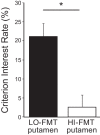Modulation of impulsivity and reward sensitivity in intertemporal choice by striatal and midbrain dopamine synthesis in healthy adults
- PMID: 26683066
- PMCID: PMC4808128
- DOI: 10.1152/jn.00261.2015
Modulation of impulsivity and reward sensitivity in intertemporal choice by striatal and midbrain dopamine synthesis in healthy adults
Abstract
Converging evidence links individual differences in mesolimbic and mesocortical dopamine (DA) to variation in the tendency to choose immediate rewards ("Now") over larger, delayed rewards ("Later"), or "Now bias." However, to date, no study of healthy young adults has evaluated the relationship between Now bias and DA with positron emission tomography (PET). Sixteen healthy adults (ages 24-34 yr; 50% women) completed a delay-discounting task that quantified aspects of intertemporal reward choice, including Now bias and reward magnitude sensitivity. Participants also underwent PET scanning with 6-[(18)F]fluoro-l-m-tyrosine (FMT), a radiotracer that measures DA synthesis capacity. Lower putamen FMT signal predicted elevated Now bias, a more rapidly declining discount rate with increasing delay time, and reduced willingness to accept low-interest-rate delayed rewards. In contrast, lower FMT signal in the midbrain predicted greater sensitivity to increasing magnitude of the Later reward. These data demonstrate that intertemporal reward choice in healthy humans varies with region-specific measures of DA processing, with regionally distinct associations with sensitivity to delay and to reward magnitude.
Keywords: delay discounting; immediate reward bias; impulsive choice; putamen; ventral tegmental area.
Figures







References
-
- Adell A, Artigas F. The somatodendritic release of dopamine in the ventral tegmental area and its regulation by afferent transmitter systems. Neurosci Biobehav Rev 28: 415–431, 2004. - PubMed
-
- Alessi SM, Petry NM. Pathological gambling severity is associated with impulsivity in a delay discounting procedure. Behav Processes 64: 345–354, 2003. - PubMed
Publication types
MeSH terms
Substances
Grants and funding
- UL1 RR-025747/RR/NCRR NIH HHS/United States
- T32 DA007244/DA/NIDA NIH HHS/United States
- R01 DA-20600/DA/NIDA NIH HHS/United States
- P60 AA-011605/AA/NIAAA NIH HHS/United States
- F31 AA020132/AA/NIAAA NIH HHS/United States
- UL1 RR025747/RR/NCRR NIH HHS/United States
- AG-044292/AG/NIA NIH HHS/United States
- F31 AA-020132/AA/NIAAA NIH HHS/United States
- F32 DA027684/DA/NIDA NIH HHS/United States
- T32 DA-007244/DA/NIDA NIH HHS/United States
- R01 DA020600/DA/NIDA NIH HHS/United States
- P60 AA011605/AA/NIAAA NIH HHS/United States
- F32 DA-027684/DA/NIDA NIH HHS/United States
- R01 AG044292/AG/NIA NIH HHS/United States
- KL2 RR025746/RR/NCRR NIH HHS/United States
- KL2 RR-025746/RR/NCRR NIH HHS/United States
LinkOut - more resources
Full Text Sources
Other Literature Sources
Medical

